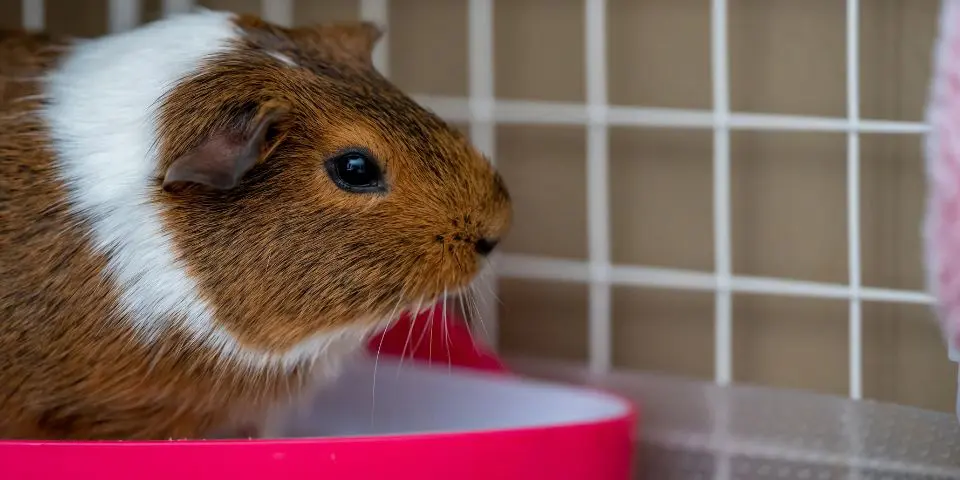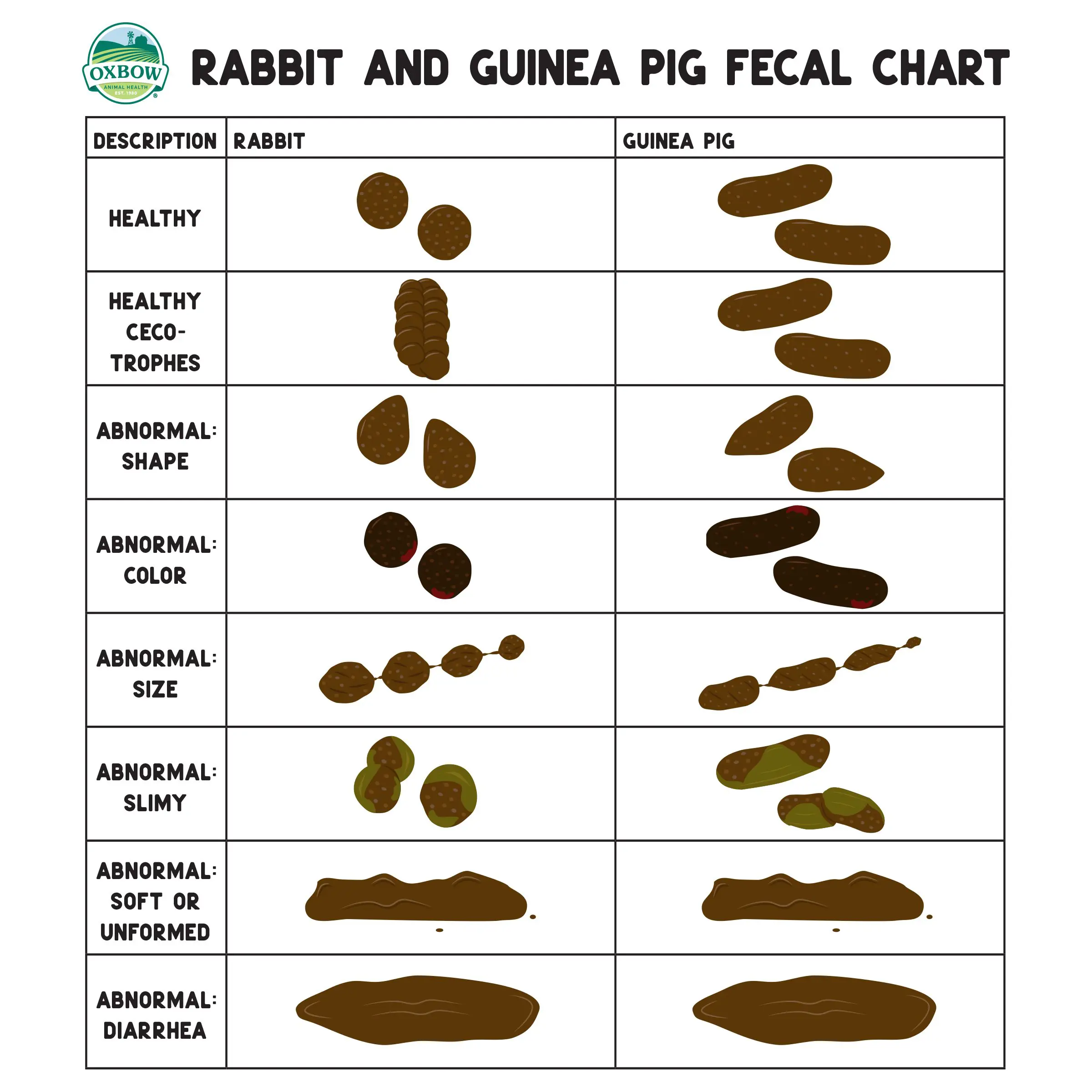Author: Dr. Cayla Iske, PhD
Let’s face the facts, we all poop…every animal does. Some species, like rabbits and guinea pigs, just do it a lot more! While far from a glamorous topic, your pet’s poops can tell you an awful lot about their overall wellbeing and what’s going on inside their body. Having an idea of your pet’s normal fecal characteristics and consistently monitoring stool production is a great tool for proactively keeping them healthy.
A change in stool is often one of the first clinical signs that your pet may be having some type of health issue. Any change in the size, shape, color, or frequency of stool output should be noted. While you might not be able to tell what the issue is right away, any change warrants a call to your veterinarian, and prolonged abnormalities in stools should always lead to a veterinary visit and consultation. Here are a few things to keep an eye out for.
Types of Rabbit & Guinea Pig Stools
A very important distinction to be made when talking specifically about small mammal droppings is that most species produce two kinds of stool. While there is still some debate on the exact mechanism between species, hindgut fermenting herbivores such as rabbits, guinea pigs, and chinchillas produce their typical fecal pellets as well as a second type of stool called the cecotropes.
Fecal Pellets vs. Cecotropes
While fecal pellets are typically small, firm, individual balls that are low moisture and appear dull, cecotropes (also known as cecals or night stools) are larger, soft, shiny, and cluster-like (think the appearance of a blackberry or cluster of grapes). A majority of cecotropes are actually ingested directly from the anus. Typically, this occurs late at night, early in the morning, and overnight so in a happy, healthy animal you might never actually see it occurring.
This also means you will rarely see the cecotropes in your little one’s cage, but don’t panic if you do see one from time to time. Reingestion of the cecotropes allows these little guys to be efficient at utilizing the nutrients in their fiber-rich diets as they, in effect, recycle their food and get a second chance to absorb the nutrients and energy it contains.
Cecotropes contain a large diversity of essential nutrients including vitamins, minerals, short-chain fatty acids, and amino acids. They also contain healthy microorganisms that are naturally shed from the gut, making them high in protein and B vitamins. Re-ingesting these nutrients helps small mammals meet their dietary nutrient requirements. Because the healthy production and consumption of cecotropes serve such an important nutritional purpose, if you suddenly notice a lot of them remaining in the cage you should call your vet straight away.
While less understood, omnivores such as rats, hamsters, and gerbils also produce poop that is re-ingested. These little guys practice coprophagy, or the act of consuming their own feces, but are not cecotrophic like rabbits and guinea pigs, meaning their re-ingested stool is not produced via a separate mechanism than the regular poop. It won’t look as distinct as an herbivore’s cecotrope, so you likely can’t tell a difference with the naked eye. Coprophagy is thought to be especially apparent during times of improper or inadequate nutrition. Like herbivores, this second pass of nutrients allows for more complete digestion and absorption of nutrients such as protein, vitamins, and minerals.

What Does Normal Rabbit & Guinea Pig Poop Look Like?
To know what’s abnormal we need to first define what is normal. Healthy small herbivores on a balanced, high fiber diet defecate a large number of small, individually formed fecal pellets. While the exact shape and form will depend on the species, and sometimes even the individual, normal poops should be uniform in shape and consistency.
Rabbits and guinea pigs rely heavily on fiber to keep the digestive tract moving, so in general, the more poop the better if they are in good form. As a reference, rabbits will typically excrete hundreds of fecal pellets every day. The color of healthy rabbit pellets is normally medium to dark brown but can vary by animal and diet, so establish a baseline for your little one.
While rabbit fecal pellets should be round and resemble peas, guinea pigs, chinchillas, rats, mice, hamsters, and gerbils often excrete more of an oval-shaped pellet that can be slightly longer.
What Does Abnormal Rabbit & Guinea Pig Poop Look Like?
When talking about poop in any species, fiber is often one of the first dietary factors to consider and is especially important in small mammals. Fiber is an extremely complex nutrient, but one main classification of fibers is soluble vs insoluble. Soluble fibers (such as oats and barley) dissolve in water to form a gel that slows movement through the digestive tract, making you feel fuller, longer. Insoluble fiber (such as hay and bran) pushes through the digestive tract promoting motility (peristalsis) and increasing defecation frequency.
Herbivores (i.e. rabbits, guinea pigs, etc.) and omnivores (i.e. rats, hamsters, etc.) both need soluble and insoluble fiber in their diet, but herbivores require more insoluble while omnivores benefit from more soluble fibers. A balance of fiber types ensures proper fecal bulk and a healthy digestive tract. For more on this and to answer other burning questions about fiber, check out our fiber 101 blog.
Abnormalities with rabbit or guinea pig stools can take a number of forms, including:
- Clusters
- Abnormal shape
- Abnormal color
- Small pellets
- Slimy stools
- Soft or unformed stools
- Diarrhea
Clusters
It may not seem like a big deal to see two or three fecal pellets clumped together (snowman type structure), and it might not be, but it could also be a very early sign of a much larger problem. Anything besides single fecal pellets can suggest a problem in the gut and may indicate the gastrointestinal (GI) tract is slowing down. There are a huge number of potential factors that could lead to this but some of the more common include reduced food intake, disruption of the bacterial flora in the GI tract (dysbiosis), improper insoluble fiber, or stress. If you notice these clusters continuing over several days, contact your vet. It will hopefully be nothing but could be an indication of a bigger issue.
Abnormal Shape
Elongated (egg-shaped) or teardrop-shaped poops can indicate a slowing of gut motility often caused by inadequate insoluble fiber, changes in GI function, or other factors. In some cases, larger than normal egg-shaped poops can indicate a rare but very serious genetic disease called megacolon in rabbits. Fecal pellets that are connected by fibers or hair, often called “string of pearls” can occur during periods of heavy shedding, especially in long-haired breeds. Be sure to groom your animal appropriately and provide plenty of fiber and fresh water to keep the digestive tract moving and processing.
Abnormal Color
Some foods contain unique pigments that can cause your pet’s feces to temporarily change colors, but you should always monitor these changes. Dark, almost black, poops can indicate excessive protein levels in the diet and in rare cases could indicate blood in the feces. If you ever observe dark stools or anything that appears to look like blood in your pets’ poops call your veterinarian immediately as there could be an obstruction, inflammation, ulceration, or laceration somewhere along the digestive tract.
Small Pellets
Small and/or dry looking fecal pellets can indicate dehydration or that your animal isn’t eating enough (specifically not getting enough insoluble and/or soluble fiber). If you observe smaller, dryer than normal poops try stimulating water intake in any way possible including offering multiple sources of water (bottle and crock) and slightly increasing intake of appropriate greens. It is also essential to ensure unlimited access to high-quality grass hay for herbivores and the bigger the variety the better! Specific to omnivores, if you are seeing smaller stool size (especially if it is linked to weight loss or lack of growth), adding a controlled amount of appropriate grains can help bulk up stools. As always, if smaller than normal fecal pellets persist more than a few days, give your vet a ring to discuss.
Slimy Stools
Mucous in your pets’ stools can occur for a variety of reasons but is more common during or after a course of medications (e.g. antibiotics) or as your pet is passing larger pieces of improperly digested food. Anything that irritates the GI tract, especially the large intestine, may stimulate the body to produce more mucous than normal to support its passage or soothe inflammation of the GI tract. Gastrointestinal parasites or abnormal physiology of the hindgut leading to impacted material in the cecum can also lead to mucous in the stools. If you notice more than a few poops covered in mucous its always best to get your vet’s advice. Strange as it may sound, bringing in a sample of the stool or snapping a photo may help them identify the cause and course of action.
Soft or Unformed Stools
This type of feces can clump together and are often softer than normal stools. Soft and unformed stools also tend to be significantly more aromatic than usual. Poops can become too soft due to excessive intake of sugary, high carb foods (even from veggies such as carrots) and/or not enough fiber (soluble or insoluble) in the diet. It can also be caused by non-dietary factors such as changes in the physiology of the GI tract, stress or, if your animal is older, may simply be a part of the natural aging process. If you observe soft, unformed stools, try to increase the fiber in the diet and cut back on high carb veggies and treats. If the problem persists, it’s always best to contact your veterinarian before it gets worse.
Diarrhea
Diarrhea has no form or structure and often appears like a cow pie or may be liquid and watery. There are many potential causes of diarrhea, ranging from an improper diet lacking fiber to parasites or infections. No matter what the cause, diarrhea always necessitates immediate veterinary attention as it can cause (dehydration, GI stasis) or is the result of (infection, parasites) major issues and can be detrimental after just 24 hours.
It may seem strange to be so in tune with your fur baby’s bowel movements, but it is one of the best ways to monitor their health and stay abreast of changes and potential ailments. Any shift in normal defecation patterns should be noted and discussed with your veterinarian. Developing a healthy baseline for your individual pet is key and knowing what potential abnormalities to look for makes it easier and more effective to monitor and communicate to your veterinarian if necessary. As discussed above, many of these fecal abnormalities can be caused by improper nutrition so it is essential to provide a nutritionally balanced diet to ensure pristine poops and a long, healthy life for your little one.

